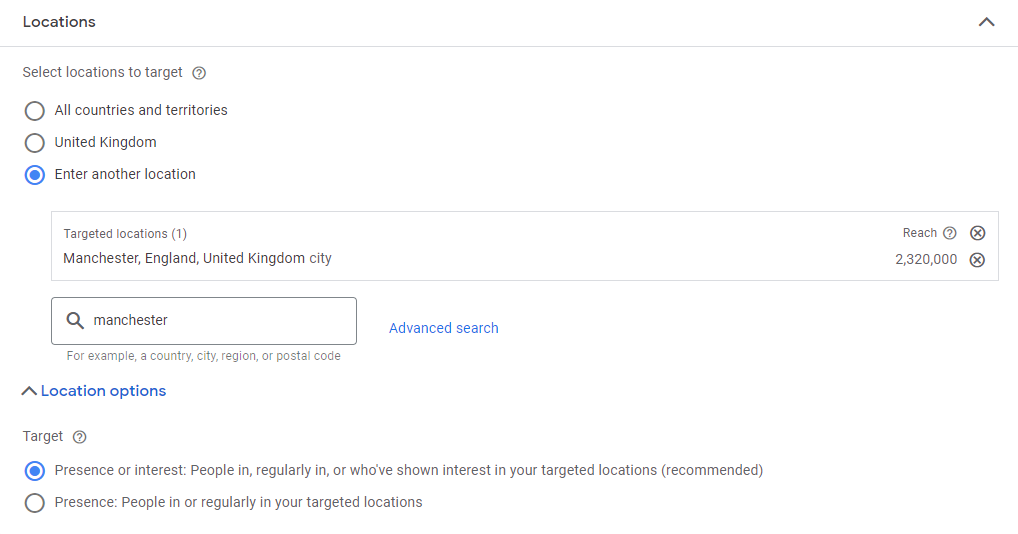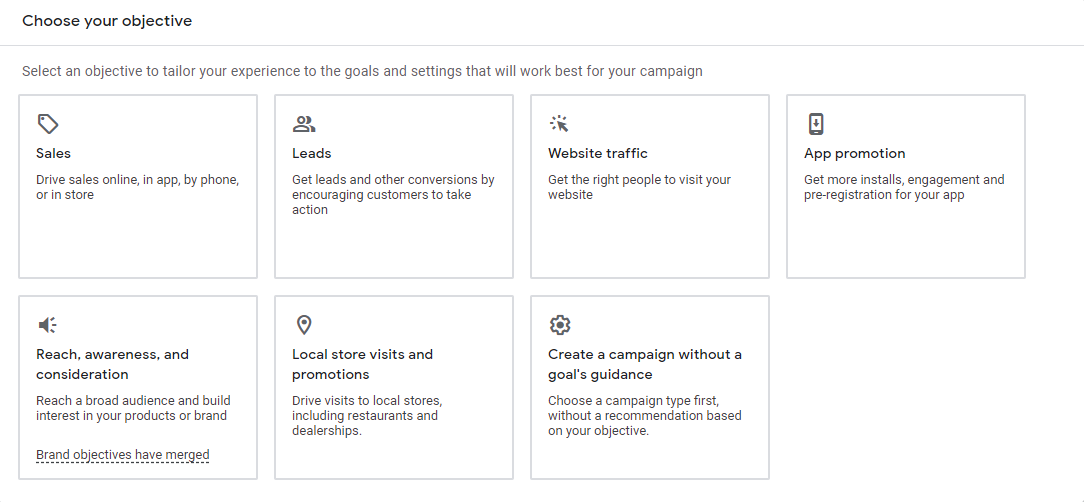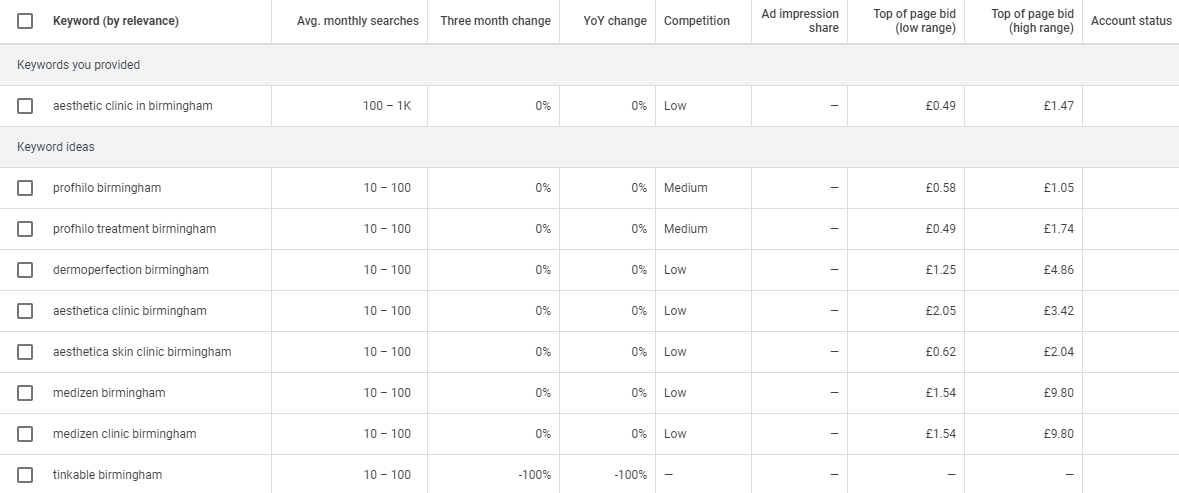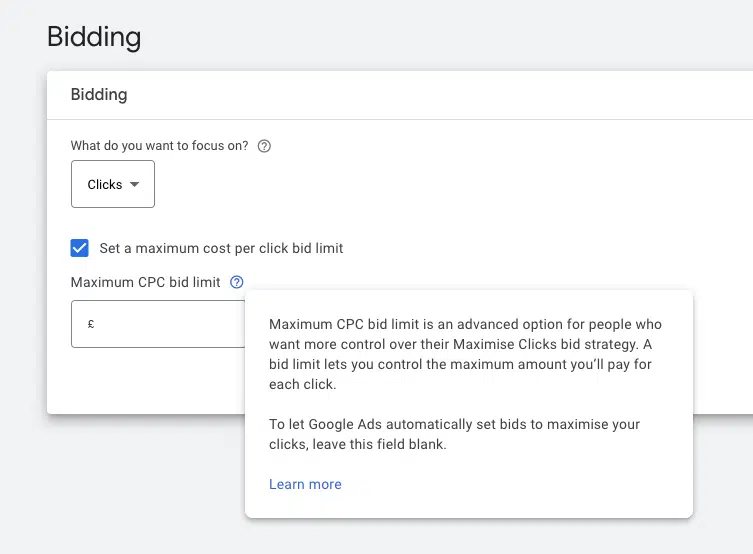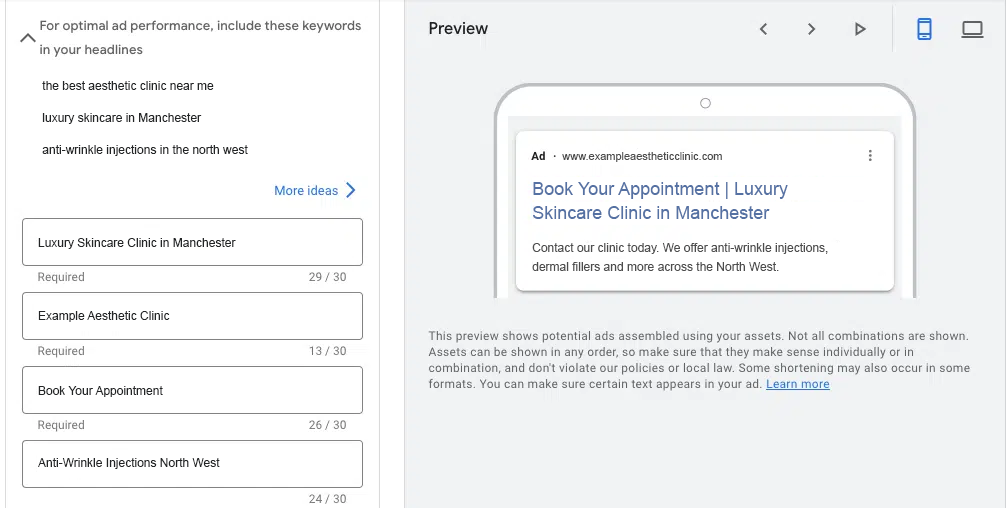PPC for Aesthetic Clinics
Gain an edge on your competitors, enjoy exceptional paid advertising results and drive more appointments with LOCALiQ’s PPC guide for aesthetic clinics.
PPC for Aesthetic Clinics
Gain an edge on your competitors, enjoy exceptional paid advertising results and drive more appointments with LOCALiQ’s PPC guide for aesthetic clinics.
PPC for Aesthetic Clinics
Gain an edge on your competitors, enjoy exceptional paid advertising results and drive more appointments with LOCALiQ’s PPC guide for aesthetic clinics.
Maximise your online visibility, attract highly qualified leads and drive more appointments to your business with PPC for aesthetic clinics. Integral to your digital marketing, a successful PPC campaign will generate quality traffic and increase your client base.
Whether you’re promoting specific treatments, showcasing before and after transformations, or highlighting the expertise of your clinic, PPC will ensure you reach the right audience at the right time.
The tools available through PPC platforms can help you increase sales and leads for your business, helping you achieve a high return on ad spend for your advertising budget.
No matter the aesthetic treatments and services you offer, easily promote these within the search engines by following our helpful paid search guide below.
What is PPC for aestheticians, and why is it important?
Aesthetic pay-per-click advertising is a powerful digital marketing strategy designed to help your clinic appear at the top of the search engine results. The instant results PPC can produce for your business make it an attractive channel for many clinics. PPC will minimise the investment to-profit period for start-ups and increasing revenue quickly for established businesses.
Utilising the power of paid search for your aesthetic clinic can transform your business, revolutionising how you reach and engage with your audience. Strategically place your skincare solutions and wellness services before anyone searching for your treatments and services in your area.
PPC for aesthetic clinics uses the same ranking criteria as pay-per-click campaigns across all industries, scoring your ads based on their relevance to your audience and helpfulness. To rank your ad, Google will use a Quality Score based on how relevant your ad copy is to your bidding keywords.
Aesthetic PPC campaigns are one of the most targeted ways to reach your local audience seeking luxury skincare. They are cost-effective and enable you to serve highly targeted ads at crucial moments in your customers’ journey. Refine your campaigns and enjoy higher conversion rates and more ROI for your advertising budget via PPC.
Common PPC terms
Before you start working on your PPC campaign, we recommend familiarising yourself with the paid search terms below and what they mean for your business.
- Cost-per-click (CPC) – the amount an advertiser pays when someone clicks their paid ad
- Click-through rate (CTR) – the number of clicks on your advert vs. the number of times it was shown (impressions)
- Conversion rate – visitors who convert into customers after clicking your advert
- Cost-per-acquisition (CPA) – the average cost of turning ad clicks into conversions
- Return on ad spend (ROAS) – the ratio of the money gained (or lost) vs. the amount spent on PPC ads
- Quality score – how Google ranks ads based on several factors, including keyword relevance
- Ad rank – a ranking that determines your ad’s position in search engine results pages
- Exact match – an option for showing your ads only when the search query is an exact keyword match
- Broad match or broad keywords – your ad will show even with keyword variations
- Ad extensions – these are added information shown below your main PPC ad. It can be a “Call” button, pricing information, or a link to a landing page
Learn more with our free resource: Search Marketing Terms You Need to Know
Benefits of PPC for aesthetic clinics
Implementing a thorough PPC marketing strategy offers several benefits for aesthetic clinics seeking to grow their online presence and attract new patients. These include:
- Immediate results and improved visibility in the search engines
- Targeted audience reach
- Flexibility in scaling campaigns based on your performance and budgets
Immediate results and improved visibility
As soon as you publish your PPC campaign, your ads can appear at the top of the search engine results, helping your clinic stand out and capture the attention of potential patients.
This instant visibility can be particularly beneficial in highly competitive aesthetic niches, where gaining an edge over other clinics is crucial for success.
Additionally, PPC advertising allows your clinic to utilise ad extensions, such as location details, site links, and CTA (call-to-action) buttons. They provide users easy access to essential information directly from the search engine results page.
By using these paid ads and ad extensions, your PPC ads become even more visible and appealing to potential patients, increasing the likelihood of attracting qualified leads.
Targeted audience reach
PPC advertising enables your clinic to target specific demographics, locations, and interests, ensuring your ads reach the most relevant audience.
Through strategic keyword selection and negative keywords, you can filter irrelevant searches and focus your paid ads on attracting users seeking aesthetic services.
This targeted approach helps to maximise the return on investment (ROI) for your PPC ad campaigns.
In addition to keyword targeting, PPC platforms like Google Ads offer advanced targeting options, such as demographic and location targeting.
These options allow your clinic to refine its audience and ensure anyone who sees your ads is more likely to convert into paying customers. By leveraging the power of targeted audience reach, you can optimise your PPC campaigns for maximum impact and ROI.
Flexibility and Scalability
PPC campaigns offer your clinic flexibility and scalability in managing its digital advertising efforts. With PPC for aesthetic clinics, you can easily adjust your PPC ad spend amount, pause underperforming campaigns, or scale up successful campaigns to maximise results.
This flexibility will empower you to enhance your PPC marketing efforts. It enables you to allocate your budget more efficiently, optimising your PPC campaigns and overall PPC marketing and ad campaign strategy.
Moreover, PPC advertising enables you to track and analyse campaign performance in real time, supporting data-driven decisions and continuously optimising your campaigns for better results.
By monitoring key performance metrics such as click-through rates, conversion rates, and cost per acquisition, your clinic can identify areas for improvement. Or, make necessary adjustments to ensure optimal budget utilisation and campaign effectiveness.
Top PPC marketing mistakes by aesthetic clinics
Using ineffective keywords
Ineffective keywords can lead to wasted ad spend and low conversion rates for your campaigns, as ads may appear for irrelevant search queries or fail to reach the intended audience.
In that case to avoid this common mistake, your clinic should conduct thorough keyword research. Utilise the Google Keyword Planner to identify relevant, high-performing keywords that align with your target audience’s searches.
We recommend incorporating negative keywords into your PPC ad campaigns to exclude incorrect searches.
For example, you might target the keyword “dermal fillers”, but your ads appear in searches related to “dermal fillers reviews”. Eliminate this by adding “reviews” as a negative keyword to your ad group. They will alert Google not to show your ad in searches that include this word.
By focusing on relevant, high-performing keywords and excluding irrelevant searches with negative keywords, your aesthetic clinic can optimise its keyword selection and maximise the effectiveness of its PPC advertising campaigns.
Poor ad copy
Poor ad copy can lead to decreased click-through rates and a less effective campaign, failing to engage potential new patients and encouraging them to click on your ad.
Your clinic should create compelling ads that address the needs and concerns of potential new patients while incorporating relevant keywords. Also, a call to action is crucial for motivating users to click on your ad and visit your website.
To further enhance your copy, we recommend A/B testing to determine which ad variations resonate best with your audience. By consistently refining your ad copy and adhering to best practices, you can boost your click-through rates and attract more qualified leads to your website.
Using irrelevant landing pages
Optimise your landing page for more conversions. All landing pages should have a clear CTA and creative content related to your treatments and services.
It’s also good practice to create multiple landing pages that appeal to different target markets (instead of sending your leads to one page), reducing the risk of penalisation from Google because the content is irrelevant to your ad.
Poor location targeting
Unless you offer aesthetic treatments and services across the UK, your PPC ads should include location-based keywords. They will narrow your target audience, increasing the odds of a click and a conversion. Removing your local keywords will result in your ad appearing in front of people within locations unsuitable for your business.
By enabling the location extension within Google Ads, you can enjoy geo-targeting, capturing users in specific locations close to your clinic.
Learn more with our free resource: How to Setup Location Targeting in Google Ads
Neglecting your PPC campaigns
Once you publish your PPC campaigns, they require constant attention to ensure you see the best results. What worked today may not work in a few weeks; continually monitoring your keywords, copy, images, and CTAs is crucial to a successful campaign.
Analyse your campaigns to determine which ads are not performing (clicks but no conversions/impressions) and test different variations to see what increases your clicks and conversions.
Our PPC services for aestheticians
Competitor Analysis
A key part of PPC for your aesthetic clinic is identifying and analysing your competitors; once you understand who they are, how they run their online ads, and the treatments and services they’re promoting, this will direct your PPC strategy.
LOCALiQ’s analysis will guide PPC techniques, from compelling ad copy and successful keywords to your targeted location strategies and audience demographics.
Campaign Creation
Once we’ve assessed your competitors and planned our strategy, we will create your PPC campaign. There are many areas to ensure you see the best results for your budget. These include;
- Choosing your campaign goals to determine why you’re running a PPC campaign (drive more traffic, lead generation, or promote a resource)
- Researching specific keywords and audiences, these will then be divided into different ad groups (for example, skincare and chemical peels ads will each have different campaigns)
- Defining your audience demographics, location, age, gender, income
- Selecting the most efficient days and times to target your audience, we will research their busiest hours and target them when they are at their most active
- Setting a daily budget which works for your business (this includes the cost-per-click and cost-per-acquisition for each ad)
- Building your adverts by including compelling copy, headlines, CTAs and images to capture your audience
- Monitoring your PPC ads to assess their performance and conversions, and if necessary, updating their features to see what improves their results by utilising A/B tests
Keyword Research
Keyword research enables us to find suitable keywords for your PPC ads, helping you discover new searches relevant to your clinic and suggestions for keywords related to your treatments and services.
These search queries will guide the content creation for your adverts, display search estimates for your keywords each month and determine your PPC ad campaign budget via average costs.
Remember, broader keywords with higher search volumes are more competitive and costly to bid on. However, lower-volume, long-tail keywords are more affordable. For your keywords, mix higher and lower-volume keywords to use in your PPC ads. They will help to balance the cost of your total campaign spend.
Discover aesthetic-related services and popular-related topics your customers are searching for with the Google Ads Keyword Planner. Generate keyword ideas, estimated monthly search volumes and many PPC metrics from their comprehensive keyword database.
How to get started
- Enter your industry-related phrases into the keyword planner – skincare, botox, non-injectable skin treatments in (location), anti-wrinkle injections near (location).
- View your keywords & their metrics – analyse different keywords by their monthly search volume, competition and costs.
- Save your keywords – save your selected keywords into an Ad Group so you can view them quickly and easily across different aesthetic areas.
- Add your negative keywords into the Ad Group; they will alert Google not to show your ad in any searches that include these keywords, maximising the effectiveness of your advertising campaigns.
Landing Pages That Convert
Alongside building your PPC campaigns, we will create a landing page for each service/audience you target within your ads.
Our landing pages will drive conversions for your ads, strategically placing effective CTAs throughout the page and increasing the chances of each visitor leaving their details so you can quickly contact them while their interest is still warm.
As PPC marketing experts, our landing pages will answer your visitors’ needs as clearly as possible, keeping things simple to help capture their details and boosting your Google Ads Quality Score to help your adverts rank higher than the competition.
Reporting and Analytics
After publishing your campaign and landing page, you will receive access to Client Centre, complete with a video tutorial explaining how to enjoy 24/7 pay-per-click reporting for your aesthetic clinic campaigns.
Exclusive to LOCALiQ, our all-in-one marketing analytics tool will help you feel safe with your investments and provide real-time reports and instant results for your PPC campaigns.
Stay in control of your marketing and enjoy cost-effective advertising decisions while achieving the maximum return on investment for your budget with Client Centre; benefits include:
- Single dashboard to view all aspects of your marketing
- Powerful insights to understand your routes to success
- Comprehensive and easy-to-use reporting
- Call tracking and recording
- Lead management and engagement
- Email marketing automation
PPC top tips for aesthetic clinics
1. Target the the right keywords
Keyword research is the first step to discovering and selecting which targeted keywords you want to use in your PPC campaigns. Google Keyword Planner can help you conduct keyword research for your PPC campaign.
Choosing the right targeted keywords is crucial to your campaign. However, most clinics make the mistake of targeting the wrong keywords in their paid ad campaign, some with high CPCs.
For an effective PPC campaign, we recommend using long-tail keywords; these are specific keywords. You will likely see more conversions for your PPC campaigns with the keyword “chemical peels near (your location)” than simply “chemical peels”.
They should also be implemented into your ad copy and optimised in your landing pages. Always target relevant keywords that match your treatments and services to increase your ad’s quality and relevance score.
Learn more with our free resource: What Are Long-Tail Keywords, and Why Are They So Important?
2. Save money by using different match types
Aesthetic-related search terms can be expensive if you’re targeting general terms. Google Ads use keyword match types to dictate when your ad appears online, depending on the search terms.
For example, you could use a “broad match” to show your ad to a wide audience or an “exact match” to target specific groups of potential clients.
When you use different match types, two things happen:
- Your relevancy potentially increases
- Your PPC cost may decrease
There are four match types available:
Broad match
Close variations of your selected keyword, related searches, and other relevant variations will trigger Google to display your PPC ad to the user. With this version, you don’t necessarily have to use the exact keyword in the search.
Broad match modifier
With this type of match, you can include any keywords that are variations or close to your identified keyword using a + sign. These additional words can appear before, after, or between the terms.
For example, if you want to target “laser therapy price in Southampton”, you can add +cost, so you capture any search terms that might use this word instead of “price”.
Exact match
Google will show your ads in search results based on exact matches of your keyword or close variations of that exact term with the same meaning.
Phrase match
Google will trigger your ad for matches of the phrase (or close variations of the phrase) with additional words before or after. For example, if “laser therapy in Southampton” is your keyword, your firm will show up for searches that include “best laser therapy clinic in Southampton” and “laser therapy clinic in Southampton reviews”.
3. Create separate ads for your target audience
As aestheticians offering different aesthetic treatments and services, consider your target audience for each PPC advertising campaign. If you practice aesthetics across many areas, including dermal fillers, botox, and skin tightening, create separate ads for each.
You will then need to organise related PPC ads into an ad group and name them according to how they are categorised. Ad groups will help you test and change specific keywords in your PPC ads.
4. Start with manual bidding
When you first create your Google Ads account and build your aesthetic PPC campaign, you’ll see several choices on how to bid. Google will recommend automatic bidding, but we recommend starting with manual bidding for your first PPC ad spend.
They will give you more control over how much you pay for each click and prevent overspending your PPC budget.
By adjusting your bid, you can enjoy the same (or better) PPC campaign performance for a lower cost.
5. Aim for a lower CPC with your PPC ads
After running your PPC campaigns for a month, you’ll have to monitor your ad’s performance and decrease their CPCs.
With this data, you can identify keywords in your PPC ads that are not performing and either pause or lower their bids. You’ll also need to increase your bids for high-performing PPC campaign ads.
As explained earlier, we also recommend using negative keywords. Negative keywords are phrases you do not want to include in your aesthetic PPC campaign.
You can find this option on the left-hand panel when clicking on a campaign name in Google Ads. When you exclude irrelevant keywords, you will improve your ad’s performance and help lower its CPC.
6. Use location-targeting in your campaigns
Google Ads has a feature that lets you create a targeted audience for your PPC campaign based on your ideal patient. When setting up a PPC ad, you can choose a location, or several, where you want to display your ads.
You can search for a city, town, or postcode and set the location as a target or exclusion.
Learn more with our free resource: Local Search Ads: How to Run a Local Search Campaign
7. Use ad extensions to boost your click-through rate (CTR)
Potential new patients will want to connect quickly to assess if your clinic solves their needs.
Likewise, you want potential aesthetic clients to get in touch so that you can generate new business with the right audience. To simplify the experience for both parties, using Google Ad Extensions is a great solution.
Ad extensions include:
- Call buttons
- Location information
- Links to specific parts of your website
According to Google, they typically increase your CTR by several percentage points.
If a potential patient is quickly searching for an aesthetic clinic on their smartphone, they will click on the first one that includes a phone number in their ad. Clicking through a website and searching for the phone number is too much work.
8. Write compelling ad copy to capture your audience
Whether you’re creating text or image ads for your PPC content, your ad copy should capture the attention of potential patients and compel them to click. If your clinic does not have the resources to write ad copy, our award-winning PPC team can support you with these.
The ad copy for Google ad campaigns is composed of the following:
- Headline (at least 3)
- Description (at least 2)
- Ad extensions
9. Ensure your landing page converts
Capturing potential leads via your PPC campaign is only half the challenge – a successful PPC campaign should convert potential leads into new customers. A conversion-focused landing page is the key to revenue-generating ads for your aesthetic clinic.
Your landing page should continue your PPC ads and lead potential patients to the next step. Our PPC team are ready to guide you with your landing pages – their experience and expertise will help to increase your ads conversion rate.
10. Optimise your website
You’ve optimised your landing pages for your target audience, but don’t forget to update your website. Your visitors will likely browse through the rest of your pages to research your clinic – this is an opportunity to showcase your industry expertise.
We recommend including your latest reviews and continually updating your aesthetic case studies to promote your best work with your patients.
11. Conduct A/B tests on your PPC campaigns
A/B tests are across many digital marketing campaigns, including web design and email marketing. For PPC advertising, running A/B tests is when two or more versions of ads run together, and you compare their results over time.
Google Ads has a guide on creating A/B tests using the “Create experiment” function. Follow these steps to run your own Google Ads experiment, whether it’s targeting different landing pages, keywords or locations.
After a few weeks of running your ads, you can check the results in your ‘Experiments’ dashboard.
You’ll see which advert resulted in a higher conversion rate, including other related stats that can influence your PPC strategy.
12. Track your PPC advertising results
Assess if your PPC campaigns generate revenue and new patients for your clinic by tracking and analysing their performance.
If you’re running Google Ads, the simplest way to track your PPC ad performance is to connect your Google Ads account to Google Analytics. See how your PPC campaigns perform, with key metrics like CPC and CPA (cost-per-acquisition), ROAS (return on ad spend) and conversion rate.
Depending on your data, you might need to improve your ads or adjust your bids for better results.
Need more help with PPC for your clinic? Our award-winning team are waiting to hear from you. Visit our PPC page to find out more and discover our many PPC services.

